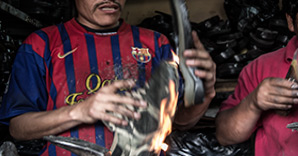 From the time we arrived back in Central America until we arrived in Lima, Peru to settle down for a few months, we were pretty much on the move all the time. Any jobs or chores that needed doing around the truck were put off – thinking that once we were embedded in our new home, we’d have a chance to catch up on all these things. We had a Lima List. A growing, expanding Lima List which the other day began to shrink as we turned our attention to getting stuff done. You know how it is.
From the time we arrived back in Central America until we arrived in Lima, Peru to settle down for a few months, we were pretty much on the move all the time. Any jobs or chores that needed doing around the truck were put off – thinking that once we were embedded in our new home, we’d have a chance to catch up on all these things. We had a Lima List. A growing, expanding Lima List which the other day began to shrink as we turned our attention to getting stuff done. You know how it is.
Curtains never got sewn up properly? Chuck it on the Lima List. Holes in shoes? Hand brake wearing out? Door frame getting loose? Weld a storage box together properly? Fix the bicycles? Man, sometimes I think we should move to an eight-day week or a thirteen month year just to give us the time to get our shit done.
 The markets in Lima are a good place to start. It is a massive area with a Chinatown section, a hair-dressing street, a collection of bike shops, an area with stalls selling road signs – you know how these developing world markets go; row after row of stalls, kiosks and stores all selling the exact same things. It’s kinda strange; on the one hand, you wonder why all these establishments exist together by type, surely, they are all in direct competition with each other. On the other hand, you know, it’s cool. Faced with a line of kiosks and holes in the wall full of shoes, their component parts and the machines to fix them – and trying to wade through the crowds of footwear-challenged customers, stepping over the shoe-shine men that are filling all the gaps, it’s like, well, I may be new to Lima but I’ve found out where you go if you need new soles on your sneakers.
The markets in Lima are a good place to start. It is a massive area with a Chinatown section, a hair-dressing street, a collection of bike shops, an area with stalls selling road signs – you know how these developing world markets go; row after row of stalls, kiosks and stores all selling the exact same things. It’s kinda strange; on the one hand, you wonder why all these establishments exist together by type, surely, they are all in direct competition with each other. On the other hand, you know, it’s cool. Faced with a line of kiosks and holes in the wall full of shoes, their component parts and the machines to fix them – and trying to wade through the crowds of footwear-challenged customers, stepping over the shoe-shine men that are filling all the gaps, it’s like, well, I may be new to Lima but I’ve found out where you go if you need new soles on your sneakers.
We made our choice and rocked up to one blackened, dirty, scruffy store, the walls lined with replacement soles and bits of cardboard, plastic and rubber all over the floor. For $10 I got to watch them rip up my shoes, glue, then put the new soles into place. Working quickly and precisely, it’s always a joy to watch craftsmen at work. I was attracted by the megalithic contraption that they use to sew the shoes together and got to talking with the guy operating it. He told me that this machine was only a few years old and cost $6000 imported from Brazil. And then he asked if there were any like this back in the UK. Maybe, in a museum somewhere, I replied, some exhibit to celebrate an industrial, manufacturing past. These days, we just throw the shoes away and get new ones. And as I said that, struggling to find space in the bustling crowds and buzzing commercial activity of hundreds of shoe-repairers and their clientele, it sounded pretty lame – that we just threw the stuff away and that a market like this wouldn’t even exist in our developed world. The guy just chewed on what I said, didn’t say a word – probably wondering the same thing as me: Where are all the advanced nations on this planet again?